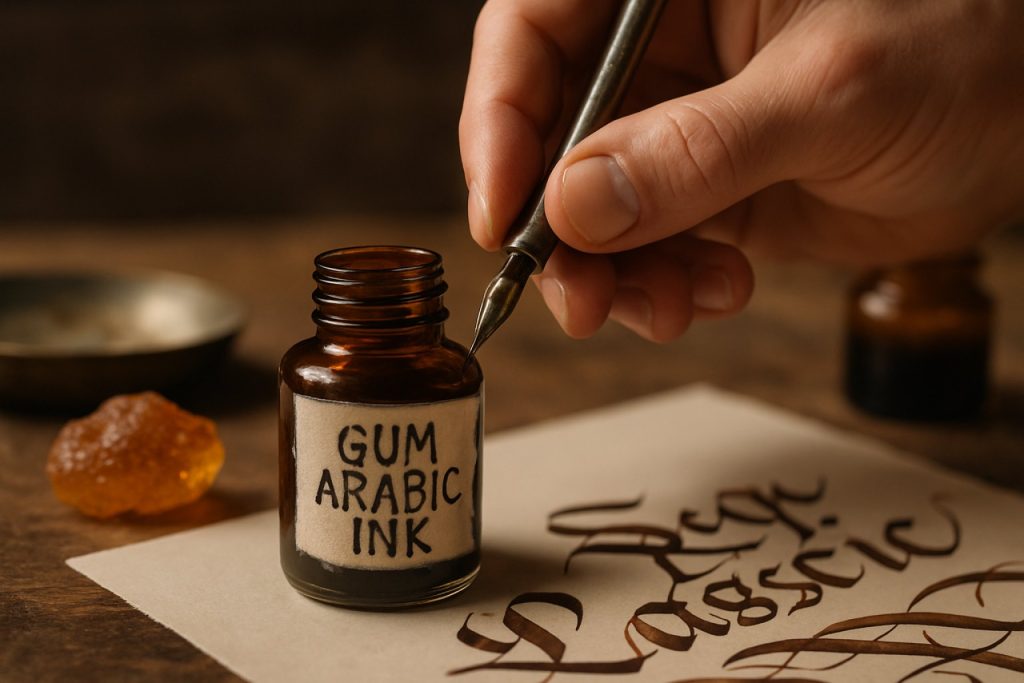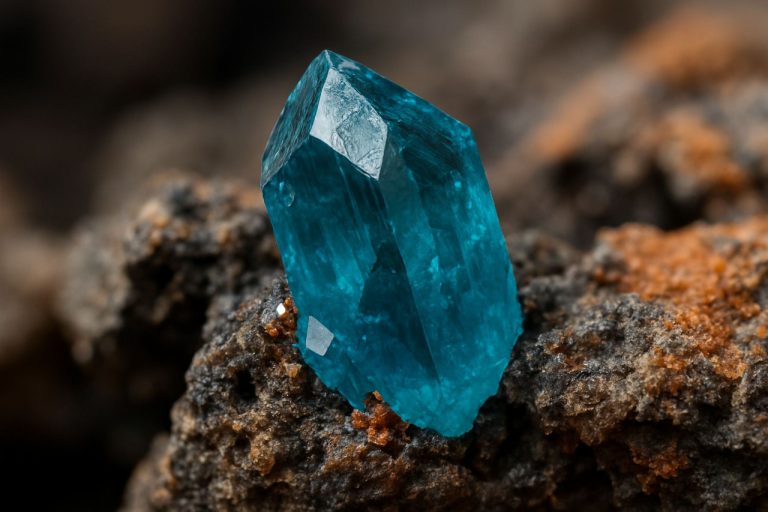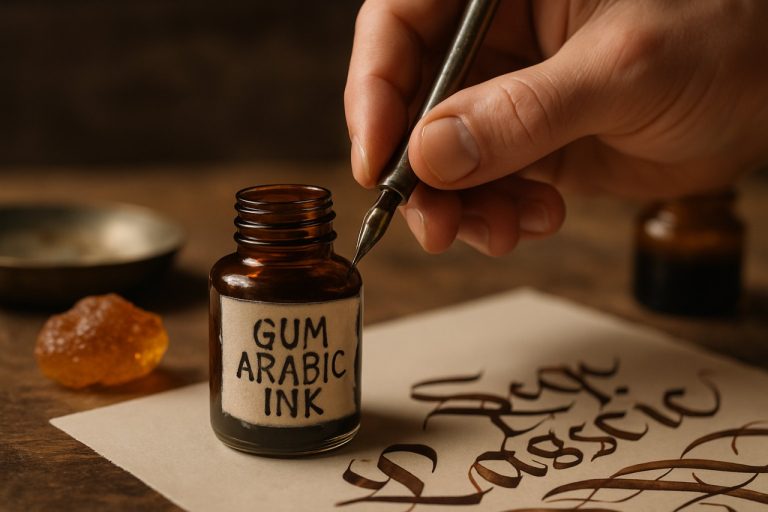
Master the Art of Making Gum Arabic Ink: Step-by-Step Guide to Crafting Vibrant, Archival-Quality Ink at Home
- Introduction: The Allure of Gum Arabic Ink
- Essential Ingredients and Tools
- Step-by-Step Ink Preparation Process
- Tips for Achieving Optimal Consistency and Color
- Troubleshooting Common Issues
- Storing and Preserving Your Homemade Ink
- Creative Uses and Artistic Applications
- Safety Precautions and Best Practices
- Frequently Asked Questions
- Sources & References
Introduction: The Allure of Gum Arabic Ink
Gum arabic ink, renowned for its rich history and versatility, has captivated artists, calligraphers, and scribes for centuries. Derived from the hardened sap of the Acacia tree, gum arabic serves as a natural binder, lending ink its smooth flow, vibrant color, and archival quality. The allure of gum arabic ink lies not only in its deep, lustrous finish but also in its adaptability—suitable for both delicate brushwork and precise penmanship. Historically, this ink played a pivotal role in illuminated manuscripts and traditional calligraphy, prized for its permanence and resistance to fading over time.
Today, the process of making gum arabic ink continues to attract enthusiasts seeking to connect with time-honored artistic practices. The craft involves blending gum arabic with pigments and water, sometimes enhanced with additives like honey or clove oil to improve texture and longevity. This hands-on approach allows for customization of color intensity and viscosity, offering a tactile and meditative experience that commercial inks often lack. Moreover, the use of natural ingredients appeals to those interested in sustainable and non-toxic art materials. As a result, gum arabic ink remains a favorite among those who value both tradition and creative control in their artistic endeavors (Victoria and Albert Museum; The Metropolitan Museum of Art).
Essential Ingredients and Tools
Creating gum arabic ink requires a careful selection of ingredients and tools to ensure the ink’s quality, consistency, and longevity. The primary ingredient is gum arabic, a natural resin harvested from the sap of Acacia trees, prized for its binding and emulsifying properties. It acts as the main binder, giving the ink its smooth texture and helping pigment particles adhere to paper. The second essential component is a pigment or dye. Traditional recipes often use lampblack (soot) for black ink, but other natural or synthetic pigments can be used for different colors. Encyclopædia Britannica, Inc.
To dissolve the gum arabic and disperse the pigment, distilled water is recommended, as it prevents impurities that could affect the ink’s stability. Some recipes include a small amount of preservative—such as clove oil or phenol—to inhibit mold growth, especially if the ink will be stored for extended periods. A few drops of glycerin or honey can be added to improve flow and prevent the ink from drying too quickly on the nib.
Essential tools include a glass or ceramic mixing bowl (to avoid unwanted chemical reactions), a mortar and pestle for grinding pigments, a fine mesh strainer or cheesecloth for filtering, and airtight bottles for storage. Accurate measuring spoons or a digital scale ensure consistent results. For application, a dip pen or brush is typically used. Properly assembled, these ingredients and tools allow for the creation of high-quality, archival gum arabic ink. The Metropolitan Museum of Art
Step-by-Step Ink Preparation Process
The process of making gum arabic ink involves a series of carefully measured steps to ensure a smooth, stable, and richly pigmented writing medium. Begin by gathering the primary ingredients: gum arabic powder, a pigment (such as lamp black or iron gall), distilled water, and a preservative like clove oil. Start by dissolving gum arabic in warm distilled water, typically at a ratio of 1 part gum arabic to 2 parts water by weight. Stir the mixture until the gum arabic is fully dissolved, resulting in a viscous solution that acts as the binder for the ink.
Next, gradually add the chosen pigment to the gum arabic solution. For lamp black ink, finely ground soot is slowly incorporated, while for iron gall ink, a pre-prepared iron gall solution is used. Stir continuously to ensure even dispersion of the pigment, preventing clumping and settling. The amount of pigment can be adjusted to achieve the desired opacity and flow characteristics. Once the pigment is fully integrated, strain the mixture through a fine mesh or cheesecloth to remove any undissolved particles, ensuring a smooth final product.
Finally, add a few drops of clove oil or another preservative to inhibit mold growth and extend the ink’s shelf life. Transfer the finished ink into a clean, airtight container for storage. Allow the ink to rest for at least 24 hours before use, which helps the components fully integrate and improves performance. For more detailed guidance, refer to resources provided by the Victoria and Albert Museum and the Metropolitan Museum of Art.
Tips for Achieving Optimal Consistency and Color
Achieving optimal consistency and color in gum arabic ink requires careful attention to ingredient ratios, mixing techniques, and the quality of raw materials. Begin by gradually adding water to gum arabic powder or solution, stirring continuously to avoid lumps. The ideal consistency is similar to heavy cream—fluid enough to flow from a brush or pen, but thick enough to hold pigment in suspension. If the ink is too thin, it may bleed on paper; if too thick, it can clog writing instruments. Adjust by adding small amounts of water or gum arabic as needed.
For color intensity, use finely ground, high-quality pigments. Sift pigments before mixing to prevent clumping. Dissolve the pigment thoroughly in a small amount of water before combining with the gum arabic solution. This ensures even dispersion and prevents streaking. The ratio of pigment to binder affects both color saturation and flow: more pigment yields deeper color but may require additional gum arabic to maintain suspension and prevent settling.
Test the ink on your intended paper, as absorbency and texture can alter the appearance. Allow the ink to dry fully before evaluating color, since wet ink often appears darker. If desired, add a few drops of clove oil or phenol as a preservative to extend shelf life and prevent mold growth, as recommended by The J. Paul Getty Trust. Store ink in airtight containers and stir or shake before each use to maintain uniformity. Regular experimentation and note-taking will help refine your process for consistently excellent results.
Troubleshooting Common Issues
When making gum arabic ink, several common issues can arise that can affect the ink’s quality, consistency, and usability. One frequent problem is the formation of lumps or undissolved particles, often caused by adding gum arabic powder too quickly to water or using water that is too cold. To prevent this, always sprinkle the powder slowly into warm, distilled water while stirring continuously. If lumps persist, straining the mixture through a fine mesh or cheesecloth can help achieve a smoother solution.
Another issue is ink separation, where pigment settles at the bottom of the container. This can result from insufficient mixing or using a pigment that is too heavy or not finely ground. To address this, ensure thorough grinding of pigments and regular stirring during use. Adding a small amount of a dispersant, such as a drop of liquid soap, can also help maintain suspension, but use sparingly to avoid foaming or altering ink properties.
Mold growth is a concern, especially if the ink is stored for extended periods. To minimize this risk, always use clean utensils and containers, and consider adding a natural preservative like a few drops of clove oil. Store the ink in airtight bottles in a cool, dark place to further inhibit microbial growth.
Finally, if the ink dries too slowly or smudges, it may contain too much gum arabic. Adjust the ratio by diluting with a bit more water or reducing the gum content in future batches. For more detailed troubleshooting and best practices, consult resources from the Royal Society of Chemistry and The J. Paul Getty Trust.
Storing and Preserving Your Homemade Ink
Proper storage and preservation are crucial to maintaining the quality and longevity of homemade gum arabic ink. After preparation, the ink should be transferred to a clean, airtight glass container to prevent contamination and evaporation. Glass is preferred over plastic, as it is non-reactive and does not leach chemicals that could alter the ink’s composition. Store the container in a cool, dark place, away from direct sunlight and heat sources, as exposure to light and temperature fluctuations can degrade the ink’s color and consistency over time.
To further extend shelf life, consider adding a few drops of natural preservative, such as clove oil or a small amount of alcohol, which can inhibit the growth of mold and bacteria. Always use clean utensils when handling the ink to avoid introducing contaminants. If sediment forms at the bottom of the container, gently shake or stir the ink before use, but avoid vigorous agitation that could introduce air bubbles or cause foaming.
Label the container with the date of preparation and the ingredients used. This practice helps track the ink’s age and identify any potential issues if the ink’s properties change. Regularly inspect the ink for signs of spoilage, such as an off odor, visible mold, or changes in texture. If any of these are observed, discard the ink to prevent damage to your writing instruments or artwork. For more detailed guidelines on ink preservation, consult resources from organizations such as the Library of Congress and the American Institute for Conservation.
Creative Uses and Artistic Applications
Gum arabic ink, prized for its versatility and rich history, finds a wide array of creative uses and artistic applications. Artists and calligraphers value this ink for its smooth flow, vibrant color retention, and archival qualities. When used in calligraphy, gum arabic ink enables precise, crisp lines and elegant flourishes, making it a staple for both traditional and modern scripts. Its compatibility with a variety of nibs and brushes allows for experimentation with line thickness and texture, which is especially beneficial in expressive lettering and illuminated manuscripts.
In painting, gum arabic ink serves as both a drawing medium and a component in watercolor techniques. Artists often use it for detailed ink washes, layering, and glazing, as the gum arabic binder enhances pigment luminosity and transparency. This property is particularly valued in botanical illustration and fine art, where subtle gradations and vibrant hues are essential. Additionally, the ink’s water solubility allows for blending and reworking, offering flexibility during the creative process.
Beyond traditional art forms, gum arabic ink is also employed in printmaking, mixed media, and experimental art. Its ability to adhere to various surfaces—such as paper, vellum, and even fabric—broadens its application in crafts and design projects. Some contemporary artists incorporate gum arabic ink in digital art workflows, scanning hand-drawn elements to merge analog and digital techniques. The enduring appeal of gum arabic ink lies in its adaptability, making it a favored choice for artists seeking both historical authenticity and modern innovation Victoria and Albert Museum The Metropolitan Museum of Art.
Safety Precautions and Best Practices
When making gum arabic ink, adhering to safety precautions and best practices is essential to ensure both personal safety and the quality of the final product. Gum arabic itself is generally considered non-toxic, but other common ink ingredients—such as lampblack (carbon black), iron salts, or certain pigments—can pose health risks if mishandled. Always work in a well-ventilated area to avoid inhaling fine powders or fumes, especially when heating or mixing substances. Wearing gloves and a dust mask is recommended when handling powdered pigments or chemicals to prevent skin contact and inhalation.
Use only clean, dedicated utensils and containers for ink preparation to avoid contamination. Glass or stainless steel implements are preferred, as they do not react with acidic or alkaline ingredients. When heating mixtures, do so gently and never leave them unattended, as overheating can cause splattering or release harmful vapors. Store all chemicals and finished ink in clearly labeled, airtight containers, away from children and pets.
Dispose of any waste materials according to local regulations, particularly if your ink contains heavy metals or synthetic dyes. Clean all equipment thoroughly after use to prevent residue buildup, which can affect future batches. Finally, keep a record of your recipes and procedures for consistency and safety in future preparations. For more detailed guidelines on safe handling of art materials, consult resources from organizations such as the Centers for Disease Control and Prevention (CDC) and the Occupational Safety and Health Administration (OSHA).
Frequently Asked Questions
What is the best ratio of gum arabic to pigment?
The ideal ratio depends on the desired consistency and application. For most calligraphy and drawing inks, a common starting point is 1 part gum arabic solution to 2–3 parts pigment by weight. Adjustments can be made for thicker or thinner ink. Always dissolve gum arabic thoroughly in water before mixing with pigment for best results (Winsor & Newton).
Can I use powdered gum arabic instead of liquid?
Yes, powdered gum arabic is often used. Dissolve the powder in warm distilled water (typically 1 part gum arabic powder to 2 parts water by weight) and let it sit overnight to ensure full dissolution. Strain the solution before use to remove any undissolved particles (Jackson's Art Supplies).
How do I prevent mold in homemade gum arabic ink?
To inhibit mold growth, store ink in sterilized, airtight containers and keep it refrigerated. Adding a few drops of clove oil or a small amount of alcohol can also act as a preservative (Handprint).
Is gum arabic ink waterproof?
No, gum arabic is water-soluble. Inks made with gum arabic will remain water-soluble and can be reactivated with water, making them unsuitable for applications requiring waterproof qualities (Tate).



